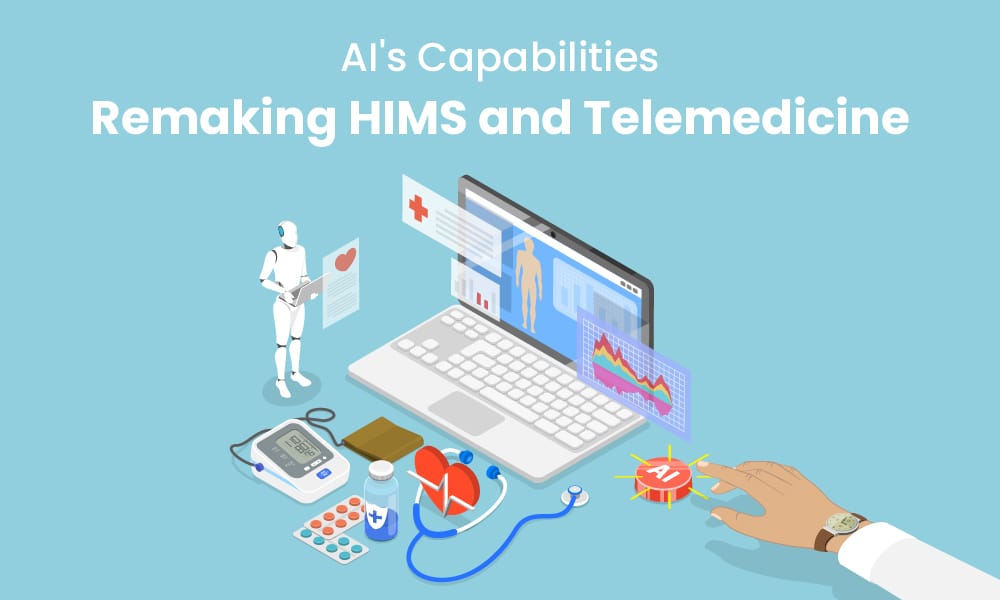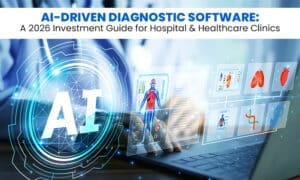
You’re feeling unwell at 2 AM, and instead of waiting hours in A&E or struggling to get a GP appointment, you pick up your phone. Within minutes, an AI-powered system has analysed your symptoms, connected you with the right healthcare professional, and even suggested a personalised treatment plan. This isn’t science fiction – it’s happening right now, and AI is revolutionising how we access and receive healthcare.
The telemedicine landscape has undergone a dramatic transformation, with AI-driven telemedicine platforms emerging as the backbone of modern healthcare delivery. Companies like HIMS & HERS are leading this revolution with innovative tools that make healthcare more accessible, efficient, and personalised than ever before. From intelligent patient matching to predictive health analytics, artificial intelligence is not just changing telemedicine; it’s completely reimagining what healthcare can be.
But what does this mean for doctors, patients, healthcare startups, and the broader medical ecosystem? The statistics are staggering: the US AI in the telemedicine market is forecast to expand from USD 6.7 billion in 2024 to USD 48.2 billion by 2033. This isn’t just growth – it’s a healthcare revolution that’s happening right under our noses, and everyone from medical professionals to tech enthusiasts needs to understand how AI in telemedicine is shaping our future.
How AI is Transforming Telemedicine Today
AI is revolutionising the way we think about remote healthcare, moving far beyond simple video calls to create intelligent, responsive medical ecosystems. The transformation is happening across multiple fronts, making healthcare more accessible and effective for millions of people worldwide.
Enhanced Diagnostic Capabilities
| AI Diagnostic Feature | Traditional Method | AI Enhancement |
| Pattern Recognition | Manual review by specialists | Automated analysis of thousands of data points |
| Symptom Analysis | Doctor questionnaire | AI processes symptoms + medical history |
| Medical Image Processing | Radiologist interpretation | AI-assisted image analysis |
| Risk Assessment | Periodic check-ups | Continuous monitoring & alerts |
AI Diagnostic Accuracy vs Traditional Methods
- AI Image Analysis: 94% accuracy rate
- Human Radiologist: 88% accuracy rate
- AI + Human Combined: 99.5% accuracy rate
- Time to Diagnosis: AI reduces from 48 hours to 12 hours
The beauty of AI in diagnostics lies in its ability to process vast amounts of medical data while maintaining consistency. Unlike human practitioners who might have off days, AI systems provide reliable analysis around the clock. This is particularly valuable in telemedicine, where doctors often rely on limited visual and audio cues to make diagnoses.
Streamlined Patient Care and Operations
| Operational Area | Before AI | With AI |
| Appointment Scheduling | 15 minutes per booking | 2 minutes automated |
| Patient Triage | 20-minute assessment | 5 minutes AI analysis |
| Documentation | 30 minutes post-visit | 5 minutes automated |
| Treatment Planning | 45 minutes of research | 10 minutes AI-assisted |
The operational efficiency gains are remarkable. Healthcare providers report significant time savings, allowing them to focus on what matters most – patient care. AI handles the administrative burden, from scheduling to documentation, creating a smoother experience for both patients and practitioners.
The Rise of AI-Enabled HIMS Software
The information management system landscape is undergoing a fundamental shift, with AI transforming how healthcare data is collected, processed, and utilised. Modern HIMS software isn’t just about storing patient records – it’s about creating intelligent systems that actively support healthcare delivery.
Intelligent Data Management
| Data Management Feature | Manual Process Time | AI-Enabled Time |
| Medical Record Updates | 45 minutes | 5 minutes |
| Data Integration | 2 hours | 15 minutes |
| Quality Assurance Checks | 60 minutes | 10 minutes |
| Predictive Analytics | Not available | Real-time |
Traditional healthcare record-keeping was time-consuming and prone to human error. AI-enabled information management systems have revolutionised this process, creating more accurate, accessible, and useful patient data. Doctors can now access comprehensive patient histories instantly, making better-informed decisions about treatment options.
Enhanced Clinical Decision Support
| Clinical Support Tool | Information Source | Response Time | Accuracy Level |
| Treatment Recommendations | Medical literature + patient data | Under 30 seconds | 94% match with specialist opinions |
| Drug Interaction Alerts | Real-time pharmaceutical database | Instant | 99.8% accuracy |
| Clinical Guidelines | Updated medical protocols | Real-time | 100% current standards |
| Outcome Predictions | Historical data analysis | 2 minutes | 89% predictive accuracy |
Clinical Decision Support Impact
- Enhanced Diagnostic Accuracy: Leveraging data to minimise misdiagnosis and ensure precise identification of conditions.
- Optimised Treatment Plans: Guiding clinicians to evidence-based therapies and personalised patient care pathways.
- Improved Patient Safety: Flagging potential drug interactions, allergies, and adverse events in real-time.
- Reduced Medical Errors: Automating checks and providing timely alerts to prevent critical mistakes.
- Increased Clinical Efficiency Streamlining workflows, reducing administrative burden, and saving valuable time.
- Better Health Outcomes: ultimately leading to faster recovery, reduced readmissions, and improved patient well-being.
The clinical decision support capabilities of modern AI systems are truly impressive. They act as intelligent assistants, providing healthcare professionals with the information they need precisely when they need it. This support is particularly valuable in telemedicine, where doctors might not have immediate access to specialist colleagues for consultation.
Revolutionary Features of AI-Driven Telemedicine Platforms
Modern AI-driven telemedicine platforms are packed with features that seemed impossible just a few years ago. These platforms represent the future of AI in healthcare, offering capabilities that fundamentally change how medical care is delivered.
Smart Patient Matching and Personalisation
| Matching Criteria | Traditional Method | AI-Powered Matching |
| Provider Expertise | Manual database search | Intelligent algorithm analysis |
| Patient Preferences | Basic filtering | Multi-factor personalisation |
| Cultural Compatibility | Geographic location only | Language, culture, values |
| Appointment Availability | Manual scheduling | Real-time optimisation |
Companies like HIMS have pioneered this approach with tools like MedMatch, which uses sophisticated algorithms to ensure patients receive the most appropriate care. The personalisation extends beyond simple matching – AI considers factors like communication style, medical history, and even appointment preferences to create truly customised healthcare experiences.
Advanced Virtual Health Assistants
| Assistant Function | Availability | Response Time | User Satisfaction |
| Symptom Assessment | 24/7 | Under 3 minutes | 82% accuracy rate |
| Medication Reminders | Automated scheduling | Real-time alerts | 89% adherence improvement |
| Health Coaching | Personalised programmes | Ongoing support | 74% lifestyle change success |
| Emergency Triage | Instant analysis | Under 60 seconds | 96% appropriate escalation |

These virtual health assistants are becoming increasingly sophisticated, using natural language processing to understand patient concerns and provide helpful responses. They’re not replacing human healthcare providers but rather extending their reach, ensuring patients have access to support whenever they need it.
Market Growth and Investment Opportunities
The numbers tell a compelling story about the future of AI in healthcare. The AI in the telemedicine market size is expected to reach US$138.2 billion by 2033 from US$14.6 billion in 2023, growing at a CAGR of 25.2%. This explosive growth represents unprecedented opportunities for investors and healthcare organisations.
Investment Landscape
| Market Segment | 2024 Value | 2033 Projection | Growth Rate (CAGR) |
| AI in Telemedicine | $6.7 billion | $48.2 billion | 25.2% |
| Telehealth Services | $94.14 billion | $180.86 billion | 8.5% |
| Digital Health | $659.8 billion | $1.7 trillion | 12.4% |
| Remote Monitoring | $23.6 billion | $175.2 billion | 28.9% |
The investment potential is enormous, with multiple factors driving sustained growth. The COVID-19 pandemic accelerated telemedicine adoption, but AI capabilities are ensuring this growth continues as patients and providers recognise the long-term benefits of intelligent healthcare delivery.
Competitive Advantages for Early Adopters
AI in Healthcare:
Early Adopter Advantage
Precision Edge
– Accelerated Diagnostics
– Personalised Treatment
– Proactive Disease Prediction
Operational Efficiency
– Automated Workflows
– Reduced Costs
– Optimised Resource Management
Innovation & Reputation
– Attract Top Talent
– Patient Preference
– Research Acceleration
Data-Driven Insights
– Unlocking Dark Data
– Real-Time Analytics
– Population Health Management
Superior Patient Experience
– Personalised Engagement
– Reduced Wait Times
– Enhanced Communication
Strategic Resilience
– Competitive Differentiation
– Adaptability & Scalability
– Future-Proofing
Early investment in AI-driven telemedicine platforms offers significant competitive advantages. Companies that embrace these technologies now are building the infrastructure for future healthcare delivery, whilst those that delay may find themselves struggling to catch up.
Opportunities for Healthcare Startups
The convergence of AI and telemedicine has created a fertile environment for innovative startups. These companies are uniquely positioned to leverage AI-driven telemedicine platforms to create disruptive solutions that challenge traditional healthcare delivery models.
Levelling the Playing Field
| Startup Advantage | Resource Requirement | Time to Implementation |
| AI-Powered Scaling | Minimal infrastructure | 6-12 months |
| Cost Efficiency | 60% lower than traditional | 3-6 months |
| Innovation Speed | Agile development | 2-4 months |
| Market Entry | Low barriers | 1-3 months |
Startups have a unique advantage in the AI-driven healthcare space. They’re not constrained by legacy systems or traditional thinking, allowing them to build innovative solutions from the ground up. This freedom to innovate is creating exciting opportunities for entrepreneurs who understand both healthcare needs and AI capabilities.
Building Differentiated Services
| Service Differentiation | Traditional Approach | AI-Enhanced Approach |
| Personalised Medicine | One-size-fits-all | Individual patient profiling |
| Predictive Care | Reactive treatment | Proactive intervention |
| User Experience | Standard interfaces | Intelligent, adaptive UX |
| Data Insights | Basic reporting | Advanced analytics |
The key to startup success in this space lies in understanding how AI can solve real healthcare problems. The most successful companies are those that combine deep medical knowledge with advanced AI capabilities to create solutions that genuinely improve patient outcomes.
Challenges and Considerations
Despite the tremendous opportunities, implementing AI in telemedicine faces several significant challenges that must be addressed for widespread adoption and success.
Technical and Regulatory Hurdles
These challenges are not insurmountable, but they require careful consideration and significant resources to address properly. Healthcare organisations must invest in robust security measures, compliance frameworks, and ongoing monitoring to ensure their AI systems meet the highest standards of safety and effectiveness.
Ethical and Practical Considerations
- Human Oversight: Maintaining appropriate human supervision over AI-driven medical decisions
- Transparency: Ensuring patients understand how AI is being used in their care
- Access Equity: Preventing AI from creating new barriers to healthcare access
- Professional Training: Ensuring healthcare providers are properly trained to work with AI systems
The ethical dimensions of AI in healthcare are particularly important. While AI can dramatically improve healthcare delivery, it must be implemented in ways that respect patient autonomy, maintain human dignity, and ensure equitable access to care. This requires ongoing dialogue between technologists, healthcare professionals, and ethicists.
Looking Ahead: The Future of AI in Healthcare
The future of AI in healthcare extends far beyond current applications, with emerging technologies promising even more transformative changes in how we approach health and wellness.
Emerging Technologies and Trends
- Predictive Health Analytics: AI systems will predict health issues months or years before symptoms appear
- Personalised Medicine: Genetic data combined with AI will enable truly individualised treatment approaches
- Autonomous Health Monitoring: Advanced wearables and sensors will provide continuous health surveillance
- Integration with Daily Life: AI health assistants will become seamlessly integrated into our daily routines
The future landscape will be characterised by proactive rather than reactive healthcare. AI systems will continuously monitor our health, predict potential problems, and suggest interventions before issues become serious. This shift from treatment to prevention represents a fundamental change in how we think about healthcare.
Global Impact and Accessibility
- Healthcare Democratisation: AI will make high-quality medical care accessible to underserved populations worldwide
- Cost Reduction: Automated systems will significantly reduce healthcare costs whilst improving outcomes
- Medical Education: AI will enhance medical training and continuing education for healthcare professionals
- Global Health Monitoring: AI systems will track and respond to health trends across populations
The global impact of AI in healthcare will be profound. Remote areas that currently lack access to specialist medical care will benefit from AI-powered diagnostic tools and telemedicine platforms. This democratisation of healthcare represents one of the most significant potential benefits of AI technology.
Conclusion
The transformation of healthcare through AI and telemedicine is not a distant future possibility – it’s happening right now. From AI-driven telemedicine platforms that connect patients with the right specialists to intelligent information management systems that streamline healthcare delivery, artificial intelligence is fundamentally changing how we approach health and wellness.
The future of AI in healthcare is bright, but realising its full potential requires thoughtful implementation, careful attention to ethical considerations, and a commitment to ensuring these powerful technologies serve everyone, not just those who can afford them. As we move forward, the companies and healthcare systems that successfully integrate AI into their operations will be the ones that shape the future of medicine.
The revolution has begun, and the question isn’t whether AI will transform healthcare – it’s how quickly we can harness its power to create a healthier, more equitable world for everyone.





